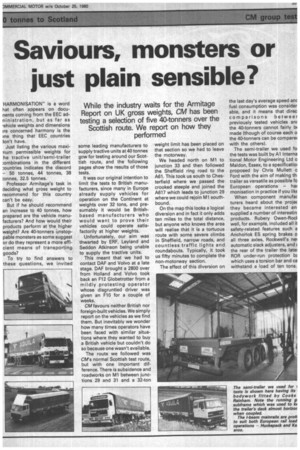Saviours, monsters or just plain sensible?
Page 37

If you've noticed an error in this article please click here to report it so we can fix it.
While the industry waits for the Armitage Report on UK gross weights, CM has been testing a selection of five 40-tonners over the Scottish route. We report on how they performed
HARMONISATION" is a word hat often appears on docu nents coming from the EEC adninistration, but as far as 'ehicle weights and dimensions ire concerned harmony is the me thing that EEC countries ion't have.
Just listing the various maxinum permissible weights for he tractive unit/semi-trailer :ombinations in the different .3ountries indicates the discord 50 tonnes, 44 tonnes, 38 tonnes, 32.5 tonnes.
Professor Armitage's task in deciding what gross weight to recommend for this country can't be easy.
But if he should recommend an increase to 40 tonnes, how prepared are the vehicle manu facturers? And how would their products perform at the higher
weight? Are 40-tonners Unstoppable monsters as some suggest or do they represent a more efficient means of transporting goods?
To try to find answers to these questions, we invited some leading manufacturers to supply tractive units at 40 tonnes gcw for testing around our Scottish route, and the following pages show the results of those tests.
It was our original intention to limit the tests to British manufacturers, since many in Europe already supply vehicles for operation on the Continent at weights over 32 tons, and presumably it would be Britishbased manufacturers who would want to prove their vehicles could operate satisfactorily at higher weights.
Unfortunately, our aim was thwarted by ERF, Leyland and Seddon Atkinson being unable to supply the tractive units.
This meant that we had to contact DAF and Volvo at a late stage. DAF brought a 2800 over from Holland and Volvo took back an F12 Globetrotter from a mildly protesting operator whose disgruntled driver was given an F10 for a couple of weeks.
CM favours neither British nor foreign-built vehicles. We simply report on the vehicles as we find them. But inevitably we wonder how many times operators have been faced with similar situations where they wanted to buy a British vehicle but couldn't do so because one wasn't available.
The route we followed was CM's normal Scottish test route, but with one important difference. There is subsidence and roadworks on M1 between junctions 29 and 31 and a 32-ton weight limit has been placed on that section so we had to leave the motorway.
We headed north on M1 to junction 33 and then followed the Sheffield ring road to the A61. This took us south to Chesterfield where we passed the crooked steeple and joined the A617 which leads to junction 29 where we could rejoin M1 southbound.
On the map this looks a logical diversion and in fact it only adds ten miles to the total distance, but anyone who knows the area will realise that it is a tortuous route with some severe climbs in Sheffield, narrow roads, and countless traffic lights and roundabouts. Typically, it took us fifty minutes to complete the non-motorway section.
The effect of this diversion on the last day's average speed an( fuel consumption was consider able, and it means that direc comparisons betweer previously tested vehicles an the 40-tonners cannot fairly b( 'made (though of course each o the 40-tonners can be compare( with the others).
The semi-trailer we used fo the tests was built by Al Interna tional Motor Engineering Ltd o Maldon, Essex, to a specificatioi proposed by Chris Mullett c Ford with the aim of making th. trailer as versatile as possible fo European operations har monisation in practice if you likE When component manufac turers heard about the projer they became interested an supplied a number of interestin products. Rubery Owen-Roci well, for example, included all it safety-related features such a Anchorlok ES spring brakes o all three axles, Rockwell's ne) automatic slack adjusters, and the rear of the trailer the later ROR under-run protection Ix which uses a torsion bar and ca withstand a load of ten tons.
























































































































































